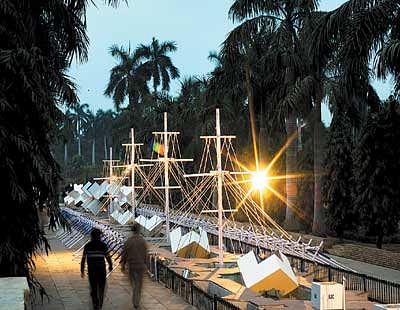
Once upon a time, all art — especially sculpture — happened to be public art, patronised by the state. That is why we now have the enduring legacy of stunning cave panels of the Mahabalipuram, or the elaborate temple carvings of a Khajuraho or Hampi, all of which took shape with the financial and moral patronage of the erstwhile rulers. Unfortunately, now in modern India, there seems to be a strict delineation between the state and the fine arts. With the exception of teaching art — in the form of the mandatory government colleges for fine arts — the state seems to have washed its hands off art. However, art requires patronage, like the sciences. And public art is special because it walks out to meet the people.
Well, the Salzburg model (a new contemporary work is added to Chennai’s public space every year, which forms a continuing dialogue with the baroque heritage of this city), maybe a farfetched hope, our country could well do with the emergence of a culture embracing a broad-based communion with art, which can only be achieved by the unfolding of more art works in public spaces.
It can’t be that the government can’t afford our artists’ prices. It is an issue of mindset. “They need to be more willing to pay the proper prices of the art works, instead of treating it as a craft issue and paying artists in chunks over labour and material costs,” says Shalini Biswajit, artist and promoter of Chennai’s Forum gallery.
For instance, the last time the local government discussed displaying serious, contemporary art pieces in traffic islands in the city, officials had apparently asked the artists to quote their labour charge and offered to supply the material, as though the entire process of creating an art work was akin to menial labour. Obviously, modern Indian governments don’t understand the intellectual value of art, or the impact that art would have on the city’s façade and its people.
Patrons of art
Put simply, Indian governments — state or central — don’t patronise art. The few times they do, the maintenance is so poor that it leaves gasps than smiles. As it happened with the sleek Rajiv Gandhi Salai, which is lined with the offices of most software firms worth their salt. This expensively done freeway, better known locally as the IT corridor road, was developed by the Tamil Nadu Road Development Corporation. TNRDC got a few leading sculptors and artists of the state to display their works, and these works initially wowed passers by with their bright hues and artistic brilliance. But now, there is zero maintenance, with no process in place even for wiping the soot from the surfaces of these art works. “You need to have some mechanism in place at least to ensure that the art works are kept cleaned and are not vandalised or misused, right?” questions Shalini, one of the artists whose installations greet passers by on the IT corridor.
Compare this sorry state to the reception that Anish Kapoor’s installations received at London late last year, courtesy the city’s Royal Academy of Arts, which painted the city red with promos for his show. Nobody flying into London could have missed knowing that Kapoor was showing his works. Meanwhile, in India, the government keeps a cool distance from art.
With the exception of a few cities like Baroda and some parts of Delhi, contemporary art works are non-existent in our public spaces. The government has to come forward and place art in the public domain, agrees RM Palaniappan, artist and regional secretary, Lalit Kala Academy, Chennai. “We artists are ready to collaborate with the local government or with corporate groups for displaying our work in public spaces. We are ready to give our works for even a small honourarium. But there should be some recognition,” says Palaniappan.
As in the way things are done in the West, there can be an open competition to decide on the art works to be displayed in chosen public spaces, with a committee voting on it. Artistes are ready to subject their works for scrutiny, but unfortunately, the only art works that local governments commission happen to be craft works or throwbacks to ancient works. If works of public art defines a city’s culture, most Indian cities would remain culturally frozen in time.
“There is no contemporary sensibility,” bemoans Palaniappan. If an installation is going to be placed in a city space such as a traffic island, it has to be synchrony with the times, so that people are able to connect with it. Otherwise, it becomes a relic, and not a statement of the times. “I have nothing against our ancient masterpieces and crafts traditions, but the space for these works are not public utility spaces like traffic junctions,” he says.
But to be fair, the state alone cannot be made to shoulder the blame. After all, the state reflects her people. “The point is, there has to be more awareness among the general public about contemporary art,” Palaniappan feels. He suggests that the media, among other agencies need to play a bigger role in this — in bringing art out of galleries and into the public gaze. As a natural fallout of this, the state would perhaps then be prompted to facilitate the placing of serious contemporary art works in public spaces.